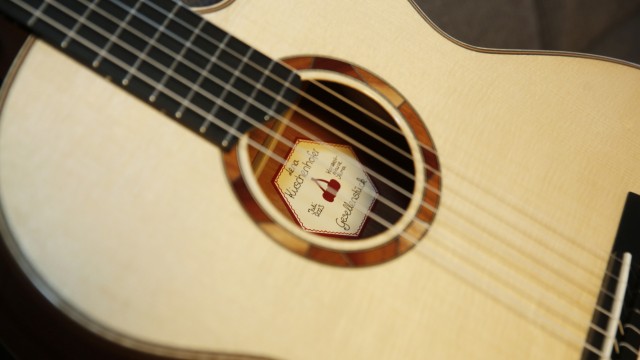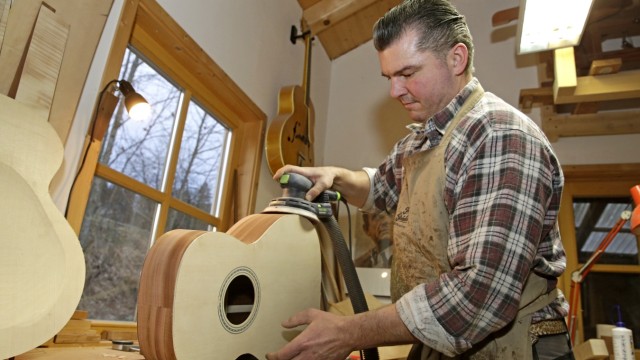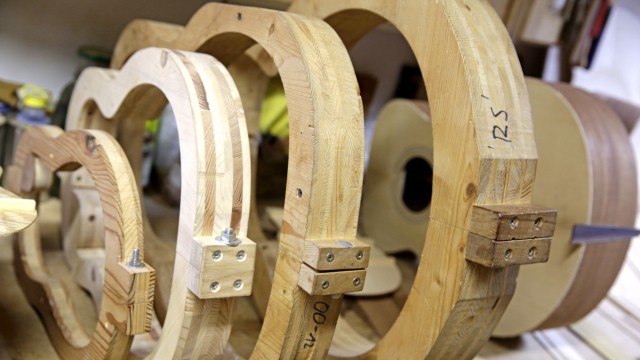Lena Kirschenhofer is the first in the workshop, but she shows no signs of morning grogginess. She holds a distinctive hybrid in her hands, half guitar, half ukulele, coffee-colored and shimmering with mother-of-pearl at the edges. A scratch, the frets are uneven, damage from use, nothing more – the Gitalele should be discharged healthy today. There is no doubt that she is in good hands with the 21-year-old plucked instrument maker from Thanning.
When she talks about her job, she uses a relaxed flow of speech, with an Upper Bavarian tone and a rolling R. She moves her hands as she does so. “Yes, mahogany is actually standard for a guitar. The most expensive ones are made of koa wood. It only grows in Hawaii and can only be cut down if it falls over on its own or there is a threat of a volcanic eruption.” It is in the Munich Guitar Company store in Haidhausen. The path leads through a forest of guitar cases to the workshop: walls crowded with files, brushes and hammers, wires sticking out of a shelf, and in the few open spaces there are piles of dead wood. Acoustic and electric guitars and a banjo hang a little higher. Underneath an Italian-style mandolin is the saying “Ceci n’est pas une guitare” – that’s not a guitar.
A little later, Lena Kirschenhofer sits at her workbench with her hair tied back and her legs crossed, scraping old paint from the body of the Gitalele. It falls in curly flakes onto her apron over her effortlessly crossed legs. Her posture is so relaxed when she works on the instrument. In September 2020 she began her training in Johannes “Joe” Striebel’s Wolfratshausen workshop. She got the training position straight after graduating from high school, she says; she had been harboring this desire for a few years. At “Girl’s Day” in 2016 – she was still attending the Geretsried high school – the spark ignited. Although she had been playing the guitar for years back then, she hadn’t asked herself where the instruments with which she made music came from: “I didn’t even realize that it existed as a profession.” The colleague at the neighboring workbench cannot suppress a snort of laughter. “Yes, how was I supposed to know that as a child?!” Lena Kirschenhofer laughs back.
The journeyman’s piece before being glued together…
(Photo: private/oh)

… and in perfect condition.
(Photo: Hartmut Pöstges)
The scratch was filled with glue. Now the area should be given a new shine by bringing it into contact with a polishing machine and its buffing wheel. “Yes, that’s what it’s called.” A searching look from calm, water-gray eyes. “There’s nothing we can’t fix, but scars always remain. We can’t perform miracles either.” The guitarele returns to the workbench, the neck is supported with cork boards. Kirschenhofer takes a precision ruler and taps the frets of the instrument with it, there is no hesitation in his hand movements. Anything that clicks as noise needs to be corrected. This service is part of the job, even if she liked building new instruments better, working with wood, and the opportunity to be creative.
She learned from Joe Striebel in a workshop that has more than 40 instrument shapes in its repertoire and sells its products to Asia, America and Willy Astor. Lena Striebel was the first trainee. “It was just a human fit,” she says. “If that weren’t the case, it wouldn’t be fun to spend three years with two people in a workshop.” The companies are small, often one-man businesses. When Kirschenhofer was awarded the first prize in the “German Craft Championship” at the beginning of December as the best plucked instrument maker in the country, the master congratulated her.

Lena Kirschenhofer learned from Joe Striebel in Wolfratshausen. She was the well-known guitar maker’s first trainee.
(Photo: Hartmut Pöstges)

More than 40 models are manufactured in his workshop.
(Photo: Hartmut Pöstges)
The frets, the metallic bumps on the fretboard of the Gitalele, need to be realigned, otherwise there will be a buzzing sound when played. An irritated click of the tongue can be heard from the workbench on the left. That doesn’t happen with Lena Kirschenhofer. With the same calmness that she now puts glue dots on the fretboard, in November, after victories at guild and state level, she completed the two tasks that were given to her in Klingenthal in Vogtland. A guitar head had to be made and a decorated sound hole rosette inserted. Kirschenhofer had never done the latter before. “But neither did the other participant, so that was exciting.”
The competition of the Central Association of German Crafts has been held since 1951. Kirschenhofer’s trainer Striebel was already a national winner. Likewise his master, Stefan Zirnbauer from Munich, where she now sits at the workbench. On December 9th she was able to pick up the prize in Berlin. Funding for later training is part of the bonus. Lena Kirschenhofer thinks about that occasionally. It’s a big step, but if you want to build guitars yourself in the future, you can’t avoid taking the master craftsman exam. Or not a degree? Not many of her graduating class went into the trades. “But I can still study; I’m interested in wood construction,” she says. In any case, training is a good foundation. For now, she is working as a journeyman in the workshop in Haidhausen. The other colleagues have now also arrived. There is a strong smell of wood, glue and varnish.
She also looked around in a carpentry shop
It removes adhesive residue from the fingerboard with elastic determination. She then rubs the frets with fine steel wool to make sure they sparkle. She struggled a bit with the profession; guitar making is a niche. Not everyone needs a guitar, but tables do. That’s why she also looked around at a carpenter’s shop. But that wasn’t ideal. Not because it was difficult for her to carry out even rougher work, she says. Nevertheless, what she appreciates about making plucked instruments is the fine workmanship and the freedom. “Besides, the old master didn’t like the fact that a woman was working in his workshop.” He didn’t have anything more to say, but it wasn’t nice.

Lena Kirschenhofer – here at home in Thanning – hardly has any time to play the guitar anymore.
(Photo: Hartmut Pöstges)
Although she is now the only woman among men in the workshop, that is not an issue. Their work fits harmoniously into the workshop rhythm of filing, sawing and hammering. If she needs help, every colleague is there for her; if she offers help, it is accepted. “Nobody is left behind here,” says the colleague, who – with long hair under his cap and a tattoo – corresponds to a completely different phenotype, but looks no more and no less like a guitarist than Lena Kirschenhofer. The variety of forms of plucked instruments corresponds to the diversity of their players. Kirschenhofer liked the classic pop repertoire, including folk music, but now he doesn’t have the time to play. “I’ll leave that to others,” she says as she oils the fretboard.
In March 2022, when she was still in training, Striebel invited her to the forest. Striebel buys whole spruce trunks to process them further. She was allowed to watch the sawing. She was there in the workshop when the wood became a guitar after a hundred hours of work. “Being able to tell the customer: ‘That’s where the tree was’ and being there from the beginning is a great experience,” she says. “It’s not just any object that we make, but a musical instrument. That’s something special.”
Then she stretches nylon strings over the body, tunes them and plucks them with the professionally long nails. The Gitalele is ready for resale. Satisfied? She smiles. “Yes.”

